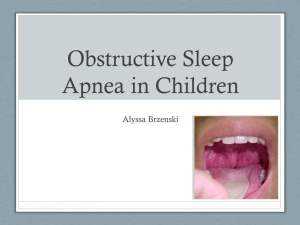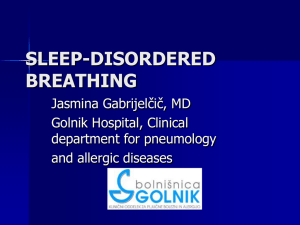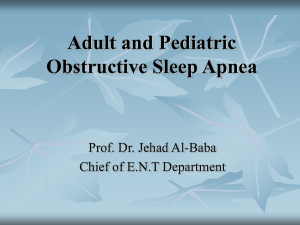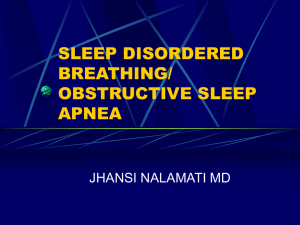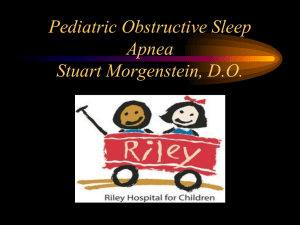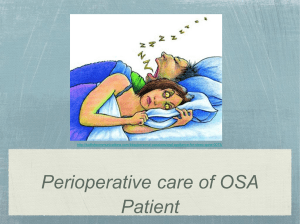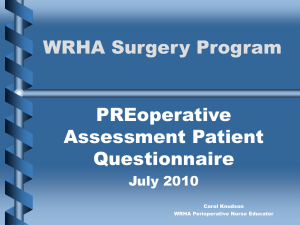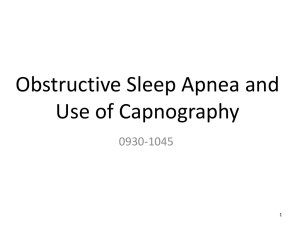OBSTRUCTIVE SLEEP APNEA - st. james healthcare education
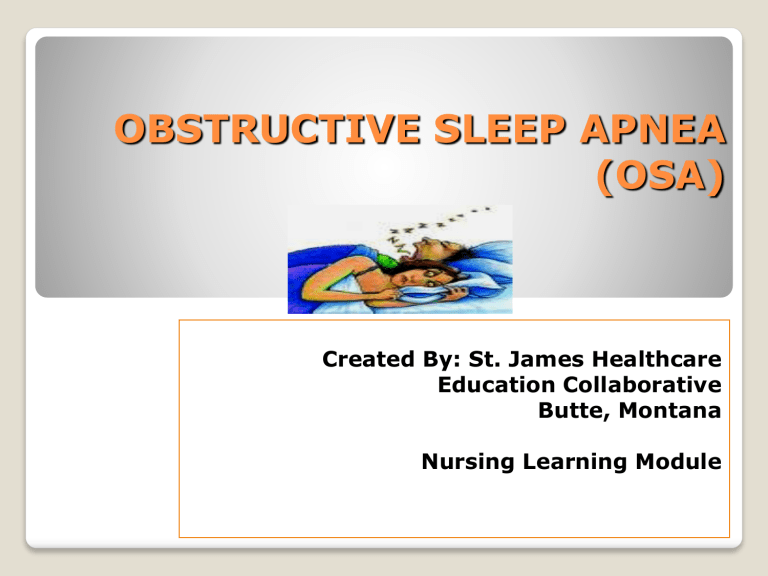
OBSTRUCTIVE SLEEP APNEA
(OSA)
Created By: St. James Healthcare
Education Collaborative
Butte, Montana
Nursing Learning Module
• To understand the challenge of OSA in a procedural or perioperative area.
Identify risk factors that influence the planning of a medication regime post procedure or post operatively.
Know the ASA recommendations for OSA postprocedurally or post-operatively.
Identify three things that will change your everyday practice.
OSA: LEARNING MODULE GOALS
1. OSA affects mostly females who are obese.
2. Patients with OSA may not be diagnosed prior to a surgical or diagnostic procedure.
3. All professional bodies have published standard guidelines for patients with OSA.
OSA: TEST YOUR KNOWLEDGE (True/False)
Care of the OSA patient may become challenging post procedure if the medication regimen does not factor in that patients with OSA are at greater risk of airway compromise during analgesia and sedation.
OSA: INTRODUCTION
Suspect OSA if a patient responds positively to screening questions about snoring and excessive daytime sleepiness;
Be aware that @ 12 to 18 million Americans suffer from OSA, and that the majority with moderate to severe OSA are undiagnosed;
OSA: IMPORTANCE OF SCREENING
There is a potential increased risk of airway compromise if OSA has not been fully evaluated prior to medication administration of narcotics / sedation.
OSA: IMPORTANCE OF SCREENING
Diagnosis is by a sleep study - measures the number of episodes of apnea (stops breathing for 10 seconds or more) as well as other factors developed by sleep medicine specialists;
The diagnosis of OSA can be :
- Mild
- Moderate
- Severe (usually requires CPAP)
OSA: DIAGNOSIS
• The muscles of the pharynx relax during stages of deep sleep, reducing the size of the airway which does not normally cause OSA.
• People with sleep apnea have airways that are narrower and more collapsible than normal.
OSA: UNDERLYING CAUSES
•
Pharyngeal muscles relax and the airway obstructs;
Hypoxemia and Hypercarbia result in central nervous system activations;
Partial arousal occurs and normal ventilation is resumed;
Sequence typically repeats several times a night, disrupting the normal sleep cycle;
Sleep apnea is usually a chronic condition;
Episodes lasting longer than 10 seconds and occurring more than 5 to 7 times an hour leads to serious health problems;
OSA: CYCLE OF HYPOXIA
Hypoxia
Hypercarbia
Brain says Wake Up!
Tired During the Day
OSA: A CYCLE OF SLEEPLESSNESS
Daytime sleepiness
Impaired cognition
Anxiety / Depression
Increased risk of occupational and motor vehicle accidents
Hypertension
Heart failure
Cardiac arrhythmias (i.e., Atrial Fibrillation)
Angina
Heart attack
OSA: MEDICAL RISKS
Patients with OSA who undergo anesthesia and/or sedation may not have received a formal diagnosis of the condition prior to a procedure;
In the absence of a sleep study, the possibility of sleep apnea should be assessed based on:
physical characteristics (in particular upper body obesity);
medical history;
interviews with patient’s family members regarding snoring and sleep patterns;
Many patients that don't look like they should have
OSA (because they are not overweight with a thick neck) do in fact have OSA;
OSA: HOW DO WE SCREEN?
Physical characteristics:
• Obesity (BMI greater than 35)
• Neck circumference greater than 17 inches for men or 16 inches for women
• Craniofacial abnormalities
• Anatomical nasal obstruction
• Tonsillar hypertrophy
OSA: PHYSICAL ASSESSMENT
Investigate whether the patient has two or more of the following observed during their sleep; or, one or
more of the following (if not observed during sleep):
• Snoring loud enough to be heard through a closed door;
• Frequent snoring;
• Observed pauses in breathing during sleep;
• Awakens from sleep with a choking sensation;
• Frequent arousals from sleep;
OSA: PATIENT HISTORY
Somnolence (one or more of the following)-
• Frequent daytime sleepiness or fatigue despite adequate “sleep”;
• Falls asleep frequently in non-stimulating environment;
OSA: PATIENT HISTORY
OSA: IMPACT OF NARCOTICS
OSA patients are more sensitive to the effects of analgesia/sedation;
Upper airway obstruction may occur after small to moderate doses of pain/anxiolytic medication;
Decreased muscle tone of the upper airway and increased airway resistance;
Airway collapse;
Interferes with the survival mechanism that normally arouses an individual during an apneic period.
OSA: IMPACT OF NARCOTICS
• Male patient, age 50, with a present medical condition of a large back wound with frequent debridements and Wound VAC.
• History: Morbidly obese, chronic back pain and surgical incisional pain (from spine surgery). Has been depressed, fatigued, and on long-term oral pain medication. No history of OSA. Patient thinks he might snore. Social situation, he lives alone.
• Question: How would you screen for OSA during your nursing admission history?
OSA: Case Example
Female patient, 25 years old, post lap chole with a common bile duct stone removed after ERCP;
Pre-procedure: anxiety level high, c/o feeling tired all of the time, denies “sleep apnea” when asked during the preadmission assessment;
Post-procedure: apneic periods observed and when patient is more awake she finally shares with the health team that a “sleep study” was recommended by her PCP to confirm sleep apnea level and treatment plan;
Self-Reflection: What else might have been done in addition to asking the patient whether they had “sleep apnea” prior to a surgical/endoscopic procedure?
OSA: Case Example
Does the patient use a CPAP (Continuous Positive
Airway Pressure) machine at home?
Solution: If Yes, consider using the patient’s CPAP to support breathing while on a pain control device or during a procedure requiring analgesia/sedation to keep the upper airway more open and decrease apneic periods caused by sedation;
OSA: HISTORY & PREVENTION
OSA: OTHER SOLUTIONS
Consider the application of a high flow nasal cannula or mask for mild to moderate sleep apnea –
OSA: OTHER SOLUTIONS
• EtCO2 Monitoring (End-Tital CO2) with PCA (Patient-
Controlled Analgesia);
• Policy # V-A 72;
• Reference Cards are available for monitoring set-up;
OSA: SJH POLICY
Modified Ramsay Scale:
• Minimal Sedation – i.e. anxiolysis (1-2, rates level of anxiety and ability to cooperate/remain tranquil)
• Moderate Sedation/Analgesia (3, responds with a normal tone of voice)
• Deep Sedation/Analgesia (4 – 6, responsive to light tactile or loud auditory stimulus to no response to stimulus)
Click in box to “allow” SJH Policy and definition of
Modified Ramsay Sedation Scale:
OSA: Modified Ramsay Scale
OSA: NARCOTICS & MONITORING
Patients at risk of OSA should have someone stay with them for 24 hours following discharge after a procedural sedation or outpatient anesthesia;
Patients who have been diagnosed with OSA should be encouraged to use their CPAP machine when resting at home.
OSA: PATIENT DISCHARGE
References –
American Society of Anesthesiologists (2006). Practice Guidelines for the Perioperative Management of Patients with Obstructive
Sleep Apnea. Anesthesiology: 2006; 104:1081–93.
•
American Society of Anesthesiologists (2008). STOP
Questionnaire: A Tool To Screen Patients For Obstructive Sleep
Apnea. Anesthesiology: 2008;108: 812-821.
ASGE (2009). Sedation Facts. Retrieved online 10/05/2009 at www.sedationfacts.org...
Gazayerli M et al (2006). A correlation between the shape of the epiglottis and obstructive sleep apnea. Surg Endosc. 2006
May;20(5):836-7.
Moos DD. (2006). Obstructive sleep apnea and sedation in the endoscopy suite. Gastroenterol Nurs. 2006 Nov-Dec;29(6):456-63.
Ramachandran, S.K. and Josephs, L. (2009). A Meta-analysis of
Clinical Screening Tests for Obstructive Sleep Apnea.
Anesthesiology. 2009; 110: 928-939.
Villegas T. (2004). Sleep apnea and moderate sedation.
Gastroenterol Nurs. 2004;27(3):121-124.
1. OSA affects mostly females who are obese.
2. Patients with OSA may not be diagnosed prior to a surgical or diagnostic procedure.
3. All professional bodies have published standard guidelines for patients with OSA.
OSA: TEST YOUR KNOWLEDGE (TRUE/FALSE)
Identify three things that will change your everyday practice.
Thank You!
~ May you have restful sleep & happy dreams ~
Susan DePasquale, CGRN, MSN
Peer Reviewed by Cheryl Stensrud, MSN and Phil Dean, RN
(2011)
